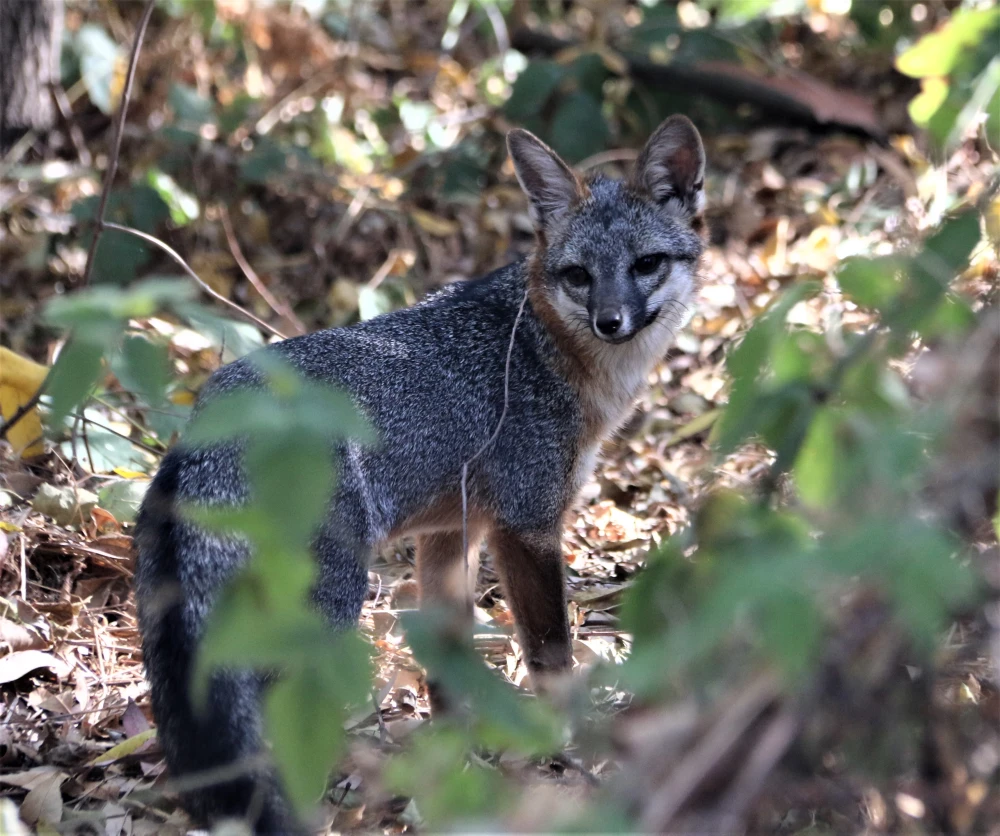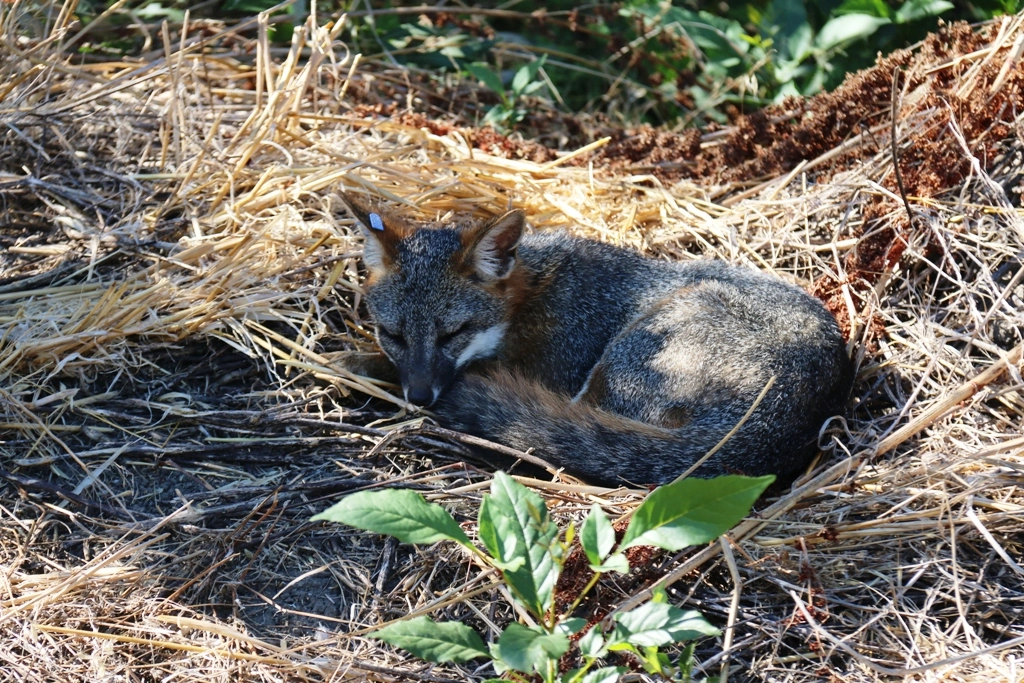My Evolution with the Gray Fox and a Few Other Thoughts
by William C. Leikam
President, CEO & Co-founder, Urban Wildlife Research Project

When I first began this study, I knew nothing, zilch, zero, nada about these foxes. I didn’t even know what kind of a fox it was when I first stumbled upon one some 12 years ago. I came into this study loaded with cliches such as sly as a fox and with a great deal of misinformation about wild animals. One of those ideas that I had carried over many years was that animals basically lived their lives driven by instinct alone. These mechanistic rules governed all animals. As such, animals were “cookies” cut from a universal genetic mold. That meant that they would act in the same manner repeatedly no matter what they did. No two foxes, no two of any other animal, did things beyond a certain limited framework and that framework was created by instinct.
That was 12 years ago and in that interim, these foxes taught me that they were sentient beings; that they could think albeit their thoughts are likely not like our own, and that they had a broad range of emotions. Such understandings caused me to rethink my eating habits for as I looked at it, if I eat say for instance bacon, I am eating the flesh of a thinking, caring, playful animal. It was akin to murder and nothing less. Gradually, I avoided the butcher shop in the supermarket.
Their ability to think first occurred to me when I saw that these wild foxes had the ability to anticipate where I would go next on my rounds as I cared for our array of trail cameras. It occurred to me that, that little fox had the ability to think into the future. Any animal that can hold a thought like that and act upon it is a thinking animal.
It was at about the same time that I saw that they acted differently from one another. There was the fearless one of the litter. That young fox seemingly had very little fear of anything, much less this giant of a human standing there along that old dirt road taking notes and photos of them. Its two siblings were unwilling to come right out on the road and look me over. I could only wonder if they thought that their sister, the one that I called Bold, had lost her mind. Then there was the loner like the female Shy who set herself apart from the others and only mixed with them occasionally. There’s the curious one of the litter like Mama Helper. As an adult, in the mornings she’d meet me in the parking lot and we’d head out on the trail. At first, she’d walk beside me, but after a while, I’d look down and she’d be gone. Often all I had to do was to look back and there she’d be sniffing plants, or sniffing along the ground. If I called, “Hey Mama Helper, come on,” she’d trot right up to me and soon repeat the same story. She was curious about most everything in her environment. Overall, she was rather independent as-long-as she didn’t have a litter to raise.
Sharing? According to the Merriam-Webster Dictionary it is defined as “… to partake of, use, experience, occupy, or enjoy with others.” You and I know what that means but to a fox to share is incomprehensible. If you could communicate such an idea to a fox, it could never fathom even a glimmer of what it meant to share. When pups are still small, they fight over the food brought in by their parents. Gradually, out of that fighting, the hierarchy within the family is born. Once that’s established, then the alpha of the litter takes first choice while the others wait their turn.
That’s it for this month. Next month I may do a retrospect of all 11 of the Gray Fox Reports for this year so that we see where we’ve been. Have a great Holiday Season and we’ll get back together in January.
Gray Foxes General Health
These two foxes appear to be in good health.
Total Numbers of Gray Foxes in the Palo Alto Baylands Nature Preserve
As of November, 2021, we have two adult gray foxes living in the Palo Alto Baylands Nature Preserve.
Section II
Update for the Urban Wildlife Research Project
Check out our Facebook page.
BE SURE TO check out our YouTube Channel for some incredible wildlife videos at https://www.youtube.com/channel/UC5ujc7p8dU1-O5AbPAWz2_Q
Check out Bill’s interview of January 1, 2021, hosted by the Town of Woodside California for their First Friday event at https://youtu.be/QrZzvmrqKTA
Undoubtedly the best Radio interview – KALW (Local PBS) Audio Recording Interviewed by Sofie Kodner during December 2020 – Broadcast 1/11/2021 5:00 PM on PBS’s program Crosscurrents https://www.kalw.org/post/bay-area-wildlife-habitats-are-disappearing-fox-guy-has-plan
Bill had a conversation with John Muir Laws and Marcia Sivek during a drawing workshop featuring the gray fox with the renowned artist John Muir Laws on January 14, 2021. It aired from noon until 1:30 PM. The Gray Fox: Art and Conservation • John Muir Laws
You can access Bill’s PowerPoint presentation Corridors & Connections: Sustaining the Health of All Wildlife presented during the October 24th P-22 Urban Wildlife Festival here: https://www.youtube.com/watch?v=Dh4MQL1D1Cc
NEW – To find out more about us, search Urban Wildlife Research Project, UWRP, gray foxes, wildlife connection, linkages, corridors and several documentaries including the video clips
If you haven’t had a chance to read some of the articles that have been written about our study of gray fox behavior and our corridor work, click on these links as they will take you to the source: Bill Leikam – The Fox Guy, and Greg Kerekes & URWP
Section III
Gray Fox, Baylands Goals
Within the permit that allows the Urban Wildlife Research Project to conduct its study of the behavior of the gray fox at the Palo Alto Baylands Nature Preserve, the objectives covered area:
- Monitoring of urban gray fox Denning sites in Palo Alto Baylands.
This is being accomplished during the period when the gray foxes use a den site. It is one of the prime locations for gathering most of the behavioral data of the litter and for adults alike.
- Assessment of status and population trends of Baylands urban gray foxes
Since January 2019 a pair of resident gray foxes have claimed territory at the Palo Alto Baylands Nature Preserve.
- Identification of habitat features that promote the presence of urban gray foxes
After considering this and talking with people who know how to restore habitats, we need to assess what kinds of plants, including the Alkaline Salt Bush, would grow best along the edge of the saltwater channel and alongside the marsh. We need to grow a permanent habitat that contains the corridors and plant it as soon as possible. We’ll keep an eye on this as this is a critical link between the southern region of the Baylands and the northern region.
- Assessment of reproductive success and identification of factors that promote successful reproduction
Open up the pinch-point along Matadero Creek by developing thickets that link one area to another, instead of the present “islands”.
- Identification and assessment of possible dispersal travel routes.
Presently there can only be guesses as to dispersal travel routes. We intend to make this important question much more concrete when we attain our collaring/take/capture permit from the Department of Fish & Wildlife.




